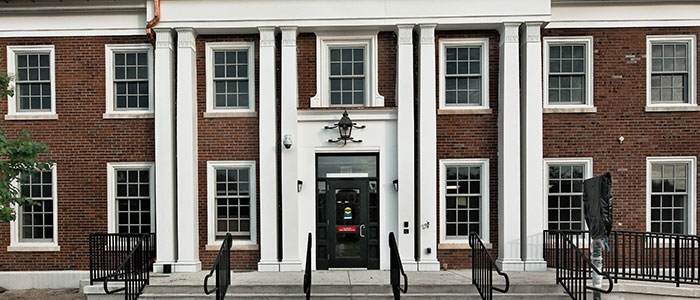ESU’s Monroe Hall Garners Prestigious LEED Gold Certification

Posted by: admin on April 11, 2014, No Comments
Monroe Hall, a historic residence hall that was converted into classrooms and other learning spaces on the campus of East Stroudsburg University of Pennsylvania, exceeded expectations when it garnered Leadership in Energy and Environmental Design (LEED) Gold Status.
The prestigious honor, awarded by the U.S. Green Building Council (USGBC), which is a nonprofit organization committed to a prosperous and sustainable future for our nation through cost-efficient and energy-saving green buildings, will be celebrated at a ceremony on Monday, April 21, from noon to 12:30 p.m. on the first floor lobby of Monroe Hall.
“We are honored that the USGBC has recognized East Stroudsburg University and the efforts that have gone into making Monroe Hall a wonderful place for students to learn in eco-friendly environment,” said ESU President Marcia G. Welsh, Ph.D.
Monroe Hall was originally constructed in 1937 as a double loaded corridor dormitory. It was refurbished in 1975, but did not receive a full life-cycle replacement and upgrade of all architectural, mechanical and electrical systems. Residence Life took Monroe Residence Hall offline in 2005 because the university could not afford the cost to add a required fire sprinkler system.
Due to the historical significance and prominence of Monroe Hall, ESU requested and received approval of a Commonwealth capital project to renovate the building as a classroom and office building rather than demolish the building. The Commonwealth funded $7.8 million of the project and ESU provided an additional $1.1 million for the project. The design firm, Highland Associates, was tasked to design the building renovation for a LEED Silver Certification. With the help of the design professional and the construction contractors (Contracting Systems, Inc., Worth and Company, Inc., Linco Construction, Inc., and Wind Gap Electric, Inc.) the project achieved a LEED Gold certification.
The Pennsylvania State System of Higher Education (PASSHE) has encouraged new campus buildings to receive Silver certification. Monroe Hall’s Gold certification is one step above what PASSHE hopes new buildings will receive.
The following are key design elements that allowed Monroe Hall to achieve LEED Gold certification:
- The renovations were designed with a geothermal system, which uses the ground’s ability to maintain constant temperature and is used to heat and cool a building. Below the frost line, approximately 4 to 6 feet, the temperature is about 55 degrees year round.
- The geothermal system designed for this building is a closed-loop piping system used to offset the need for fossil fuels such as gas or oil, which has helped reduce our carbon footprint.
- The Quad in front of Monroe Hall contains a closed-loop piping system consisting of 48 well borings at a depth of 200 feet that are connected to the building by horizontal pipes below grade. Circulating pumps circulate fluid through the piping system and to each heat pump throughout this building. Fluid at the heat pump acts as a heat source, or sink, depending on whether the heat pump is heating or cooling. In the winter, the heat pump draws the heat from the fluid to warm the interior air. During the summer, the process is reversed and the heat pump rejects the heat to the fluid which in turn is rejected to the ground.
- Nearly 75 percent of all construction waste was diverted from landfill disposal.
- Building materials that do not emit harmful chemicals were selected for this building.
- More than 20 percent of the project’s material costs consist of products containing recycled content or materials that originated within a 500-mile radius of the project site.
- Renovations to the envelope and energy systems have yielded an estimated savings of 25 percent when compared to the previous condition of the building.
- HVAC equipment was designed and selected to be a highly efficient system, requiring less energy to operate than standard HVAC systems.
- Lighting –Savings greater than 20 percent were realized by installing energy-efficient, fluorescent fixtures. Lamps are rated at 3500 Kevin and provide a natural light effect.
- Low-flow, water-efficient faucets and toilet fixtures yield water savings of 40 percent per year.
- Greater than 90 percent of all storm water that accumulates on-site will be naturally treated to reduce solid impurities by 80 percent.
- Storm water runoff quantities were reduced by nearly 45 percent when compared to predevelopment rates.
- Permanent irrigation systems are not required due to the incorporation of native vegetation.
- Exterior bike racks are provided to further enhance our goal to be a sustainable campus.
- Recycling containers have been conveniently located to reduce the amount of waste in local landfills.
Search
Recent Posts

Julianna and Wayne Bolt Art Contest Winners Selected for the 29th Annual Martin Luther King Jr. Celebration
December 10, 2025 - Read more

ESU Hosts 8th Annual Dr. Barbara G. Collins Social Work Professional Development Day
December 4, 2025 - Read more

ESU Professor Elected to American Society of Plant Biologists Steering Committee
November 25, 2025 - Read more

ESU Women’s Rugby Club Team Headed Back to Division III National Championships
November 25, 2025 - Read more
